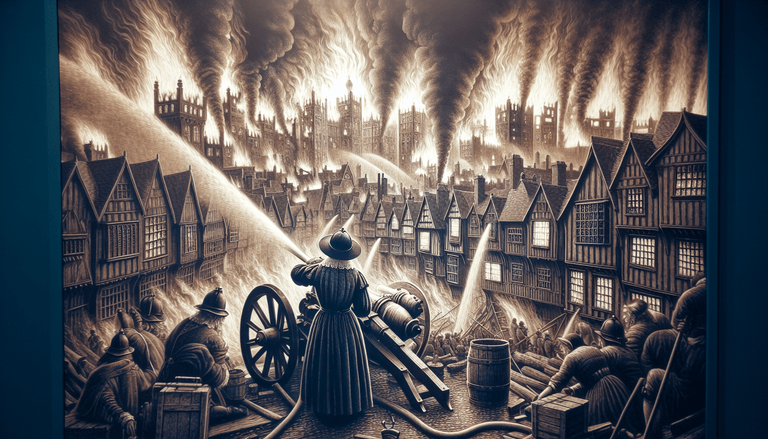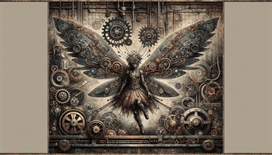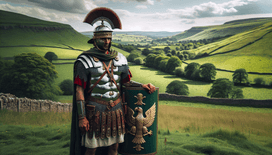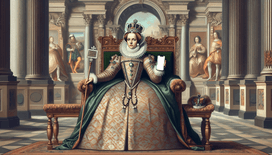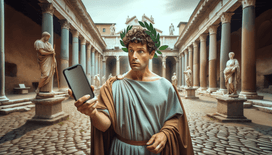Ah, the Great Fire of London: a blazing bonanza that lit up 1666 brighter than a disco ball at a 70s-themed party, only with far less glamour and a great deal more scorched toast. It's a historical event so sizzling that it continues to intrigue us centuries later. But what if, I dare muse, our firefighting forebears had been armed not with buckets and goodwill, but with modern-day water cannons? Imagine the scene, a splashy spectacle of extraordinary aquatic heroics, London might have been more hot tub than inferno!
The Flaming Starter's Gun: Pudding Lane
Our fiery tale commences not on Fleet Street nor in the heart of Westminster, but at a humble bakery on Pudding Lane, where one Thomas Farriner allegedly failed to extinguish his oven properly. Cue the flames! Had poor Thomas had access to modern notifications, perhaps courtesy of a nifty smartphone app named "BakeSafe" buzzing in his ear with a jaunty jingle, the dough might've been his only concern.
Imagine Thomas' phone chiming, "Oi, mate! Your bread's on fire," providing a prompt nudge towards bakery bliss sans blaze. Alas, tech-less Thomas retired to bed, blissfully unaware that his bakery was about to become the hottest spot in town for all the wrong reasons.
Bucket Brigade vs. Super Soaker Squads
To combat the inferno, London traditionally relied on a rag-tag team of bucket-wielding citizens, as effective as a sieve in a storm. Now, envision if these volunteers had been equipped not with leaky wooden pails but with the might of industrial-strength water cannons, blazing a path through the flames with torrents of high-pressure H2O.
The scene might resemble the world's largest water fight, with firemen darting through the streets, water cannons in hand, dispensing streams with all the precision and force of a Formula 1 team under pressure. The Great Fire might soon have been reduced to a few steamy puddles, leaving Sir Christopher Wren without the opportunity to showcase his architectural acumen on a grand scale.
The Curious Case of Samuel Pepys' Cheese
No account of the Great Fire is complete without mentioning Samuel Pepys, the diarist whose eye for detail made him the Instagram influencer of his day. Pepys famously buried his wine and a parmesan cheese wheel to safeguard them from the flames. Don't worry, Sam, your cheese is safe, but what if you'd had state-of-the-art fireproof storage?
Pepys might have engaged a smart security system to protect his lactose lauds and vinous valuables, all while lounging in the comfort of his home, contentedly checking alerts on his smartwatch. "PepysSecure alerts: your parmesan is cool as a cucumber," it might boast, leaving only the logistics of outwitting marauding mice to manage.
The Aftermath: Rebuilding on a (Flame-Free) Foundation
After the last flames were tamed, albeit manually, the task of reconstructing the capital was as massive as a zeppelin on stilts. With water cannons in our alternate history, we'd witness a less charred cityscape and perhaps a less stress-filled Sir Christopher Wren, relieved from reinventing an entire skyline from scratch.
Symbolically, Wren might have still championed rebuilding efforts, but perhaps centred more on ergonomic elegance than emergency extraction, allowing him room to inject a little panache into a city with fewer jagged edges and more gleaming domes.
History's Splash Zone
In this waterlogged iteration of history, one can't help but wonder what side splash effects might ripple across time. Would tourism have soared like a piano hung by a thread, as visitors flock to see the intact pre-fire London, its historic heart unblemished by flame? Might we find Pepys' infamous parmesan immortalised in curdled pop culture for its daring escape from fiery demise?
Ultimately, as we tread the soggy path through this damp and delightful tête-à-tête with the past, it's evident that technology's tide, though unforeseeable in 1666, would have radically rewritten how we extinguish the hot-headed whims of history itself. And so, dear reader, when next you browse the history shelves, spare a thought for water cannons, and the history we might have unleashed with their aqueous artillery.
